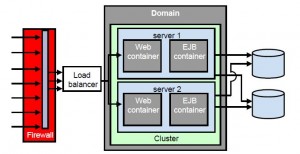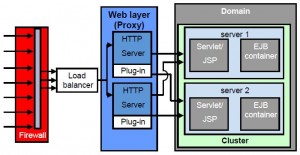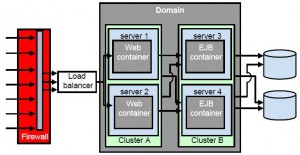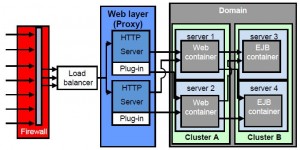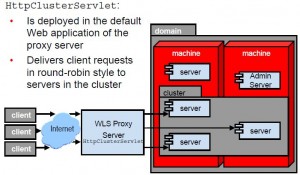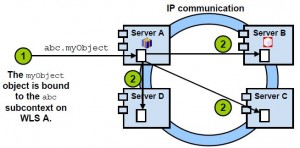Contents
<< Previous
Desribe a WebLogic Server cluster
What is a Cluster
* A cluster is a logical group of managed servers within a domain
– managed servers can reside on different machine
– a cluster can not span across more than one domain
* Provide failover and high availability for:
– whole servers
– web apps and services: relies on HTTP session state replication
– EJB apps: relies on replica-aware stubs, enabled in weblogic-ejb-jar.xml
– JDBC resources
– JMS
* Is transparent to clients
Benefits of Clustering
* Scalability: add more server instances to support higher load
* Load balancing: distribute work across members
* Application failover
* Availability
* Migration: for pinned services and components (e.g. JTA)
What can be Clustered
* Servlets
* JSP
* EJB
* RMI objects
* JMS destinations
* JDBC connections
Proxy Server
* Software based:
– WebLogic servlet, i.e. HTTPClusterServlet
– Web server plug in, e.g. mod_wl_ohs
– third party application
* Hardware based, e.g. F5 Big IP
Compare basic to multi-tier cluster architectures
Basic Cluster Architecture
* Advantages:
– easy admin
– flexible load balancing
– robust security
* Disadvantages:
– EJB method calls not load balanced
Basic Cluster Proxy Architecture
* Static content is hosted on HTTP servers
Multitier Cluster Architecture
* Advantages:
– improved load balancing (more options: presentation tier, business tier)
– fewer points of failure
– EJB method calls are now load balanced
– improved security options (different security policy for presentation tier and business tier)
* Disadvantages:
– no collocation optimization (network traffic between presentation tier and business tier)
– higher cost
– more configuration complexity
Multitier Cluster Proxy Architecture
* Static content is hosted on HTTP servers
Proxy Plug-ins
* Delegates dynamic content requests to WLS servers
* Uses round robin
* Based on cookie or URL rewrite
* OHS uses mod_wl_ohs as default proxy plug-in
HttpClusterServlet
Describe cluster communication (heartbeats, peer-to-peer)
* Peer to peer: uses IP sockets
– access pinned objects
– access clustered objects that reside on a remote server instance
– replicate HTTP session states and stateful session EJB states between primary and secondary server
* One to many: uses Unicast (preferred) or Multicast (deprecated)
– cluster wide JNDI updates
– cluster heartbeats
Next >>
[mv_include id=’3268′]

